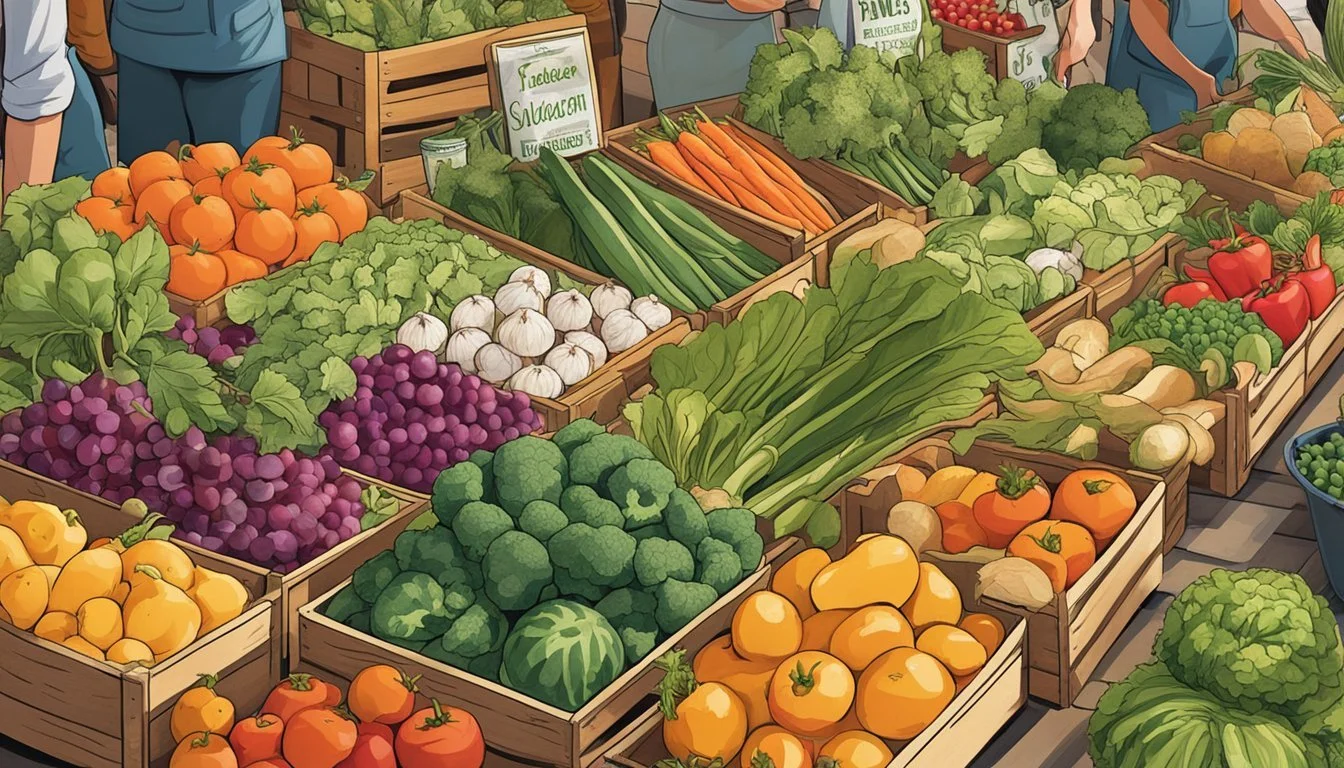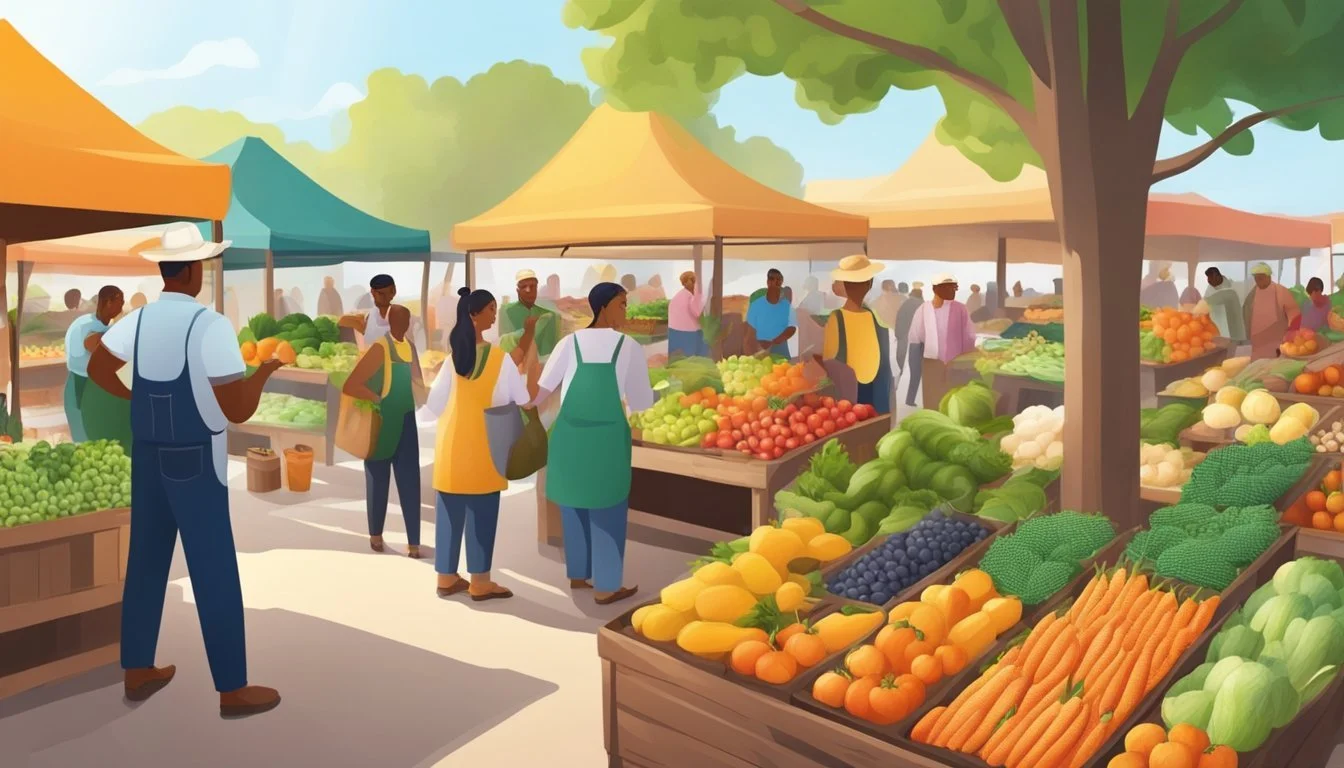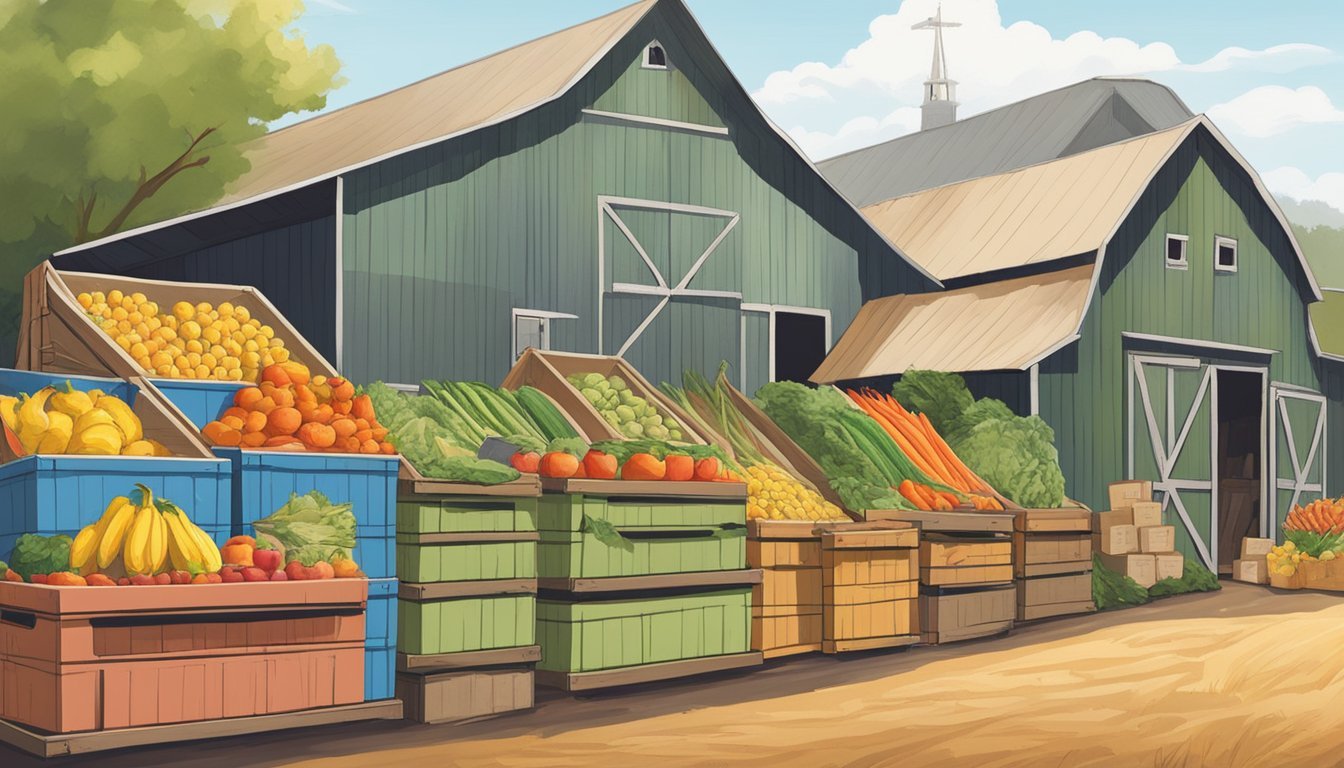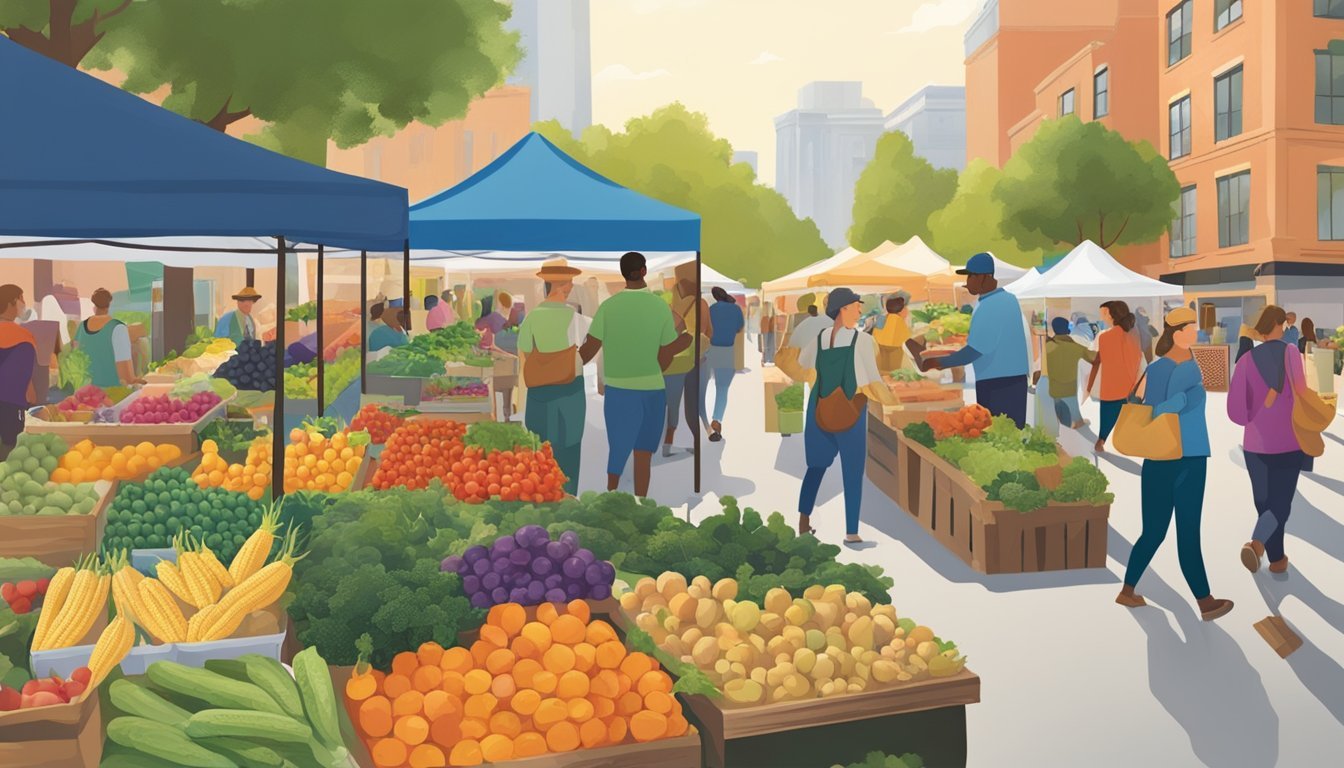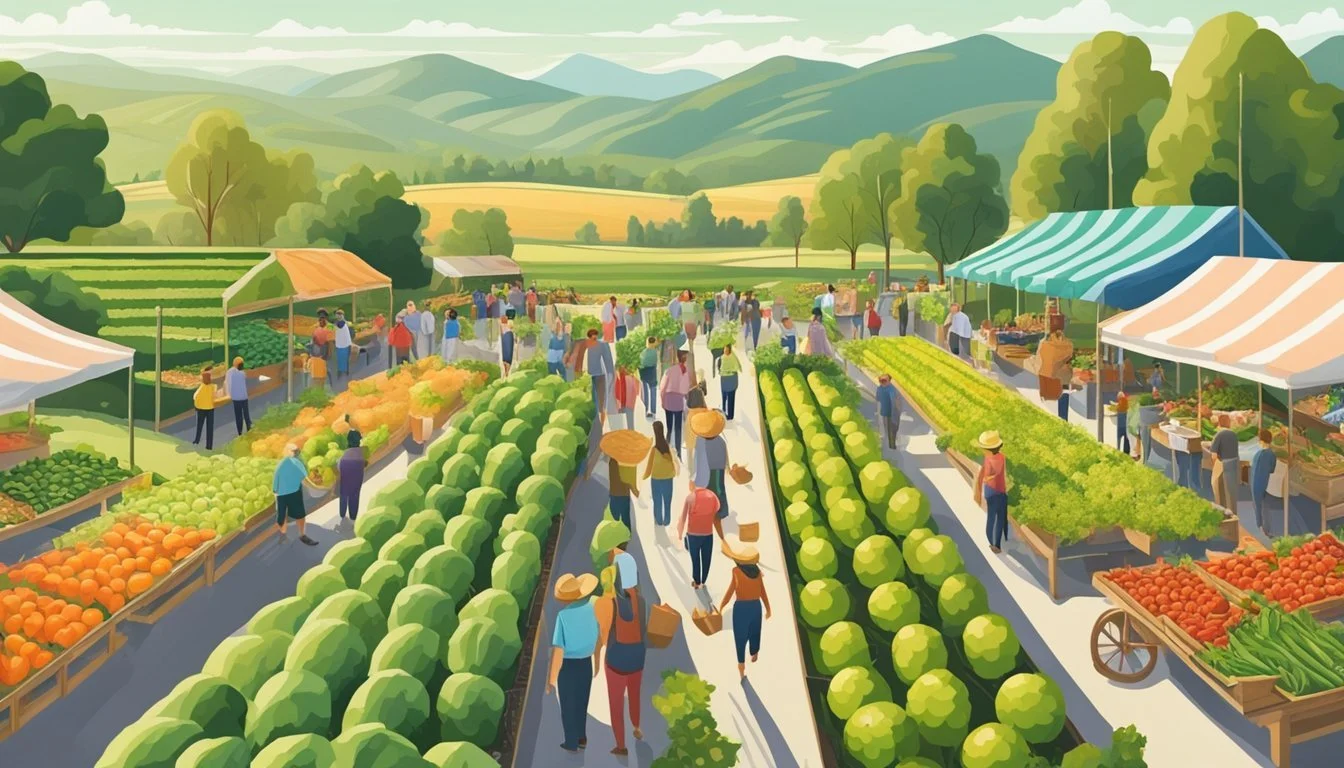Community Supported Agriculture (CSA) in Oregon
Advantages and Local Impact
Community Supported Agriculture (CSA) has taken a strong foothold in Oregon, a reflection of the state's investment in sustainability and local agriculture. Through CSA programs, consumers directly support local farmers by purchasing shares of a farm’s harvest in advance. This model benefits the consumer by securing a season's worth of fresh produce and other farm products, while offering farmers a stable income and a dedicated market. The focus is on high-quality, locally-grown food, fostering a direct link between the production and consumption of agricultural goods.
In Oregon, the CSA system is not just about the exchange of goods but is deeply intertwined with the values of community engagement and support for local agriculture. The state's rich agricultural landscape offers a diverse array of CSA options, delivering everything from vegetables and fruits to eggs and meats. Pioneering farmers have been committed to extending the reach of fresh, nutritious food to more communities, particularly to those that are underserved.
These programs across Oregon are characterized by their dedication to sustainable farming practices. Many participating farms are either certified organic or adhere to organic standards, emphasizing the health of the soil and ecosystems. By supporting CSAs, Oregonians are not only contributing to the local economy but also participating in a movement that prioritizes environmental stewardship and the well-being of their communities.
History of CSA in Oregon
Community Supported Agriculture (CSA) has a relatively young history in Oregon. In the early 1990s, Oregon saw the emergence of CSAs as a response to the growing concerns over the effects of industrialized agriculture. These CSAs reflected a dedicated effort to strengthen the local food economy by directly connecting consumers with the sources of their food.
Willamette Valley, a region known for its fertile soil and agricultural diversity, became a nurturing ground for the CSA movement in Oregon. Farmers in the valley embraced the CSA model, seeing it as a means to provide quality, fresh produce directly to their communities while also ensuring a stable income stream.
Oregon Tilth, a leading organization in advocating organic farming and sustainable agriculture practices, has played a significant role in supporting and accrediting CSA farms. Through Oregon Tilth’s support, many Oregon CSA farms adhere to organic farming principles, providing additional assurance to consumers about the quality and sustainability of their produce.
Throughout the state, consumers participate in CSA programs by purchasing subscriptions, where in return they receive seasonal shares of locally grown, often organic, produce. By the following year, the CSA landscape in Oregon had maturely developed with many farms catering to the demand for local, sustainable food.
Here's a succinct timeline of CSA developments in Oregon:
Early 1990s: Introduction of CSAs in Oregon.
1990s Onwards: Expansion of the CSA model in Willamette Valley and other regions.
Continuous Growth: Increased participation by consumers and support through organizations like Oregon Tilth.
Oregon's embrace of the CSA model highlights a commitment to sustainable farming and community engagement in food production. CSAs remain a testament to Oregonians' values of environmental stewardship, support for local farmers, and the pursuit of healthy eating habits.
Benefits of Joining a CSA
Joining a Community Supported Agriculture (CSA) program presents a variety of compelling advantages for both the individual and the community. One of the primary benefits is access to fresh, local produce. Members receive a CSA share, often a basket or box, filled with a diversity of seasonal vegetables and fruit. This produce is typically harvested at its peak, offering superior flavor and nutritional value.
Participation in a CSA also supports local farmers, ensuring that they have a guaranteed market for their goods. This financial stability may allow farmers to employ sustainable farming practices more efficiently, which provides long-term benefits to the environment. Additionally, many CSA programs prioritize organic methods, reducing the reliance on synthetic pesticides and fertilizers, which can be beneficial for both the consumer's health and the ecosystem.
The act of directly purchasing a share from a CSA promotes a tight-knit community as consumers develop relationships with those who grow their food. It fosters a better understanding of the source of their food and the effort required to produce it, which can cultivate greater appreciation and responsibility towards food consumption.
Furthermore, CSA members commonly enjoy the surprise and diversity of receiving different produce with each share, encouraging culinary creativity and exploration of new recipes. Adjusting diets to include more seasonal and organic vegetables and fruits can have positive health implications, potentially leading to a more balanced and nutritious diet.
By choosing to join a CSA, individuals contribute to a sustainable food system that benefits the environment, the economy, and the health of the community.
How CSA Works
Community Supported Agriculture (CSA) in Oregon connects consumers directly with local farms, offering a structured approach to buying fresh, seasonal produce. By acquiring memberships, customers receive a portion of the harvest throughout a predetermined timeframe, with various pickup or delivery options to receive their shares.
Membership and Shares
People interested in joining a CSA must first purchase a membership, often referred to as buying a "share". A share represents a portion of the farm's produce and is typically paid for up-front before the season begins. This model grants farms upfront capital to plan and manage the agricultural season effectively. Memberships are commonly available in different sizes to suit different household needs or preferences, such as:
Individual/Couple share: Suitable for 1-2 people
Family share: Intended for a family unit
Seasonal Offerings
CSA shares predominantly consist of fresh produce, tailored to the changing seasons. A summer share might include tomatoes, cucumbers, and berries, while a fall share could offer squash, apples, and root vegetables. Seasonality ensures that members get a variety of produce at the peak of freshness and taste. Farms might occasionally include other items such as eggs, dairy, or meat, adding diversity to the offerings.
Pickup and Delivery Options
Lastly, the distribution of CSA shares is managed through scheduled pickup or delivery options. Farms often have specific days and locations where members can pick up their produce, sometimes directly on the farm, at local farmers' markets, or at designated community spots. Alternatively, some CSAs provide home delivery services, possibly incurring additional fees, to bring the farm's bounty directly to members' doorsteps, which has become increasingly relevant and appreciated by consumers seeking convenience and safety.
Popular CSA Farms in Oregon
Community Supported Agriculture (CSA) in Oregon connects consumers directly with farmers for high-quality, local food. These include a diverse offering from vegetable produce to sustainable seafood.
Portland Area CSA
Beaverton Holiday U-Cut Christmas Tree Farm: Located in the Portland area, this family-owned farm has been offering a unique holiday experience since 1978, providing customers the chance to select their Christmas trees directly from the source.
Sun Love Farm: Nestled in Oregon City, Sun Love Farm passionately commits to delivering fresh, local produce to the community.
Willamette Valley CSA
Deck Family Farm: Based in the heart of Willamette Valley, they provide an array of pasture-raised meats, upholding a commitment to sustainable and humane farming practices.
Gathering Together Farm: They are renowned for their wide variety of organic vegetables, which are distributed to their CSA members, as well as local markets and restaurants.
La Terra Vita: With a dedication to organic farming, La Terra Vita ensures that CSA members in the Willamette Valley receive nourishing and flavorful produce all season.
Southern Oregon CSA
Moomaw Family Farm: They emphasize the importance of sustainable livestock practices while offering CSA shares that include high-quality meats in and around the Southern Oregon area.
Port Orford Sustainable Seafood: They extend beyond traditional farming by offering shares of locally and responsibly harvested seafood, contributing to the health of ocean ecosystems and providing Southern Oregon with fresh catches.
In each area, Oregon prides itself on a vibrant network of farms and fisheries that foster local food culture, encourage sustainable practices, and build strong community ties through CSA models.
CSA Products Beyond Vegetables
Community Supported Agriculture in Oregon extends well beyond the realm of organic vegetables. Members can enjoy a diverse array of products that include fresh meats, seasonal fruits, and aromatic herbs and flowers.
Meat and Seafood Offerings
Oregon CSAs offer a variety of pastured meats ensuring high-quality protein is available to their members. This includes:
Beef: Often grass-fed and finished, providing a rich and robust flavor.
Chicken: Typically free-range, with access to outdoor spaces.
Lamb: Raised on pastures, producing tender and flavorful cuts.
Some CSAs may also extend to seafood, especially in coastal regions, with options such as fresh, local fish and shellfish.
Fruits and Orchards
Fruit offerings from CSAs include a range of berries and orchard fruits. These often feature:
Berries: Strawberries, raspberries, and blueberries, picked at their peak.
Orchard fruits: Apples, pears, and cherries, which are staples in Oregon's fruit baskets.
CSAs allow members to taste the freshness of fruits straight from the farm, with the variety dependent on seasonal availability.
Herbs and Flowers
Herbs and flowers are additional highlights of CSA shares. Customers may find:
Herbs: A mix of culinary and medicinal herbs like basil, mint, and lavender.
Flowers: Beautiful, often edible, blooms that can serve as delightful decor or be used in recipes.
These products enrich the CSA experience, providing flavors, aromas, and aesthetics that supermarket alternatives cannot match.
Community Impact and Support
Community Supported Agriculture (CSA) initiatives in Oregon have a profound impact on local communities and align closely with state resources that bolster support for small farms and expand knowledge on sustainable agriculture practices.
Support for Local Farmers
CSAs offer tangible support for local farmers in Oregon by providing them with a consistent and reliable customer base. This direct-to-consumer model alleviates marketing stresses and guarantees income, allowing farmers to focus on quality food production. Farmers are supported by organizations like Oregon Tilth and the OSU Extension Small Farms Program, which provide a wealth of resources promoting organic agriculture and responsible farming methods.
Economic Benefits
The economic benefits of CSAs are twofold: they secure a livelihood for local farmers and retain spending within adjacent communities. Money spent on CSA shares stays in the local economy, circulating among local businesses and services. This financial model fosters a healthier economy that is resilient to global market fluctuations.
Educational Resources
CSAs serve as valuable educational platforms, bringing awareness to food sourcing and sustainable agriculture. Websites and blogs maintain ongoing dialogues about CSA best practices and share stories that resonate with consumers. For instance, the Pacific NW Community Supported Agriculture website offers insights and updates through its blog. Educational resources are further bolstered by the OSU Extension Small Farms Program, which not only spreads knowledge on efficient farming techniques but also adapts to changing market conditions, supporting small-scale farmers across Oregon.
Navigating CSA Memberships
When considering a CSA membership in Oregon, individuals should focus on selecting suitable farms, comprehending the CSA agreements, and exploring various payment options including SNAP benefits.
Finding the Right Farm
One starts by researching for a CSA farm that aligns with their preferences and location. Directories and guides are invaluable resources for this purpose. The Pacific NW CSA Coalition is a key entity for finding local CSAs, which allows for the discovery of farms that provide an array of produce and meet individual needs.
Directories to Consult:
Pacific NW CSA Coalition
LocalHarvest
Furthermore, potential members may want to consider factors such as the variety of produce available, farm practices, and proximity to their home.
Understanding CSA Agreements
A CSA share typically involves a regular delivery or pickup of fresh produce, and sometimes other farm products, throughout the growing season. Before one subscribes, it's important to read and understand the CSA agreement as it outlines:
Duration of the subscription (weekly, monthly, annual)
Type and quantity of produce to expect
Pick-up/delivery arrangements
Farm's policies on missed pickups or cancellations
Members should be aware that by joining a CSA, they share in the risks of farming such as weather impacts and crop failures.
Payment Options
CSA members can usually choose from several payment options, including full payments or installment plans. They should inquire about the payment schedules and if any discounts are available for early sign-ups or full upfront payments.
Common Payment Methods:
Cash
Check
Credit/Debit Card
Online Payment Platforms
For those with limited income, it is important to note that many farms in Oregon accept SNAP benefits for CSA shares. This effort to increase access to healthy food for underserved communities not only supports local agriculture but also ensures that fresh produce is available to all segments of the population.
SNAP-Eligible CSA Programs:
Check with individual farms or look for a directory that indicates SNAP-eligible CSAs.
Marketing and Promotion of CSAs
Marketing and promotion strategies for Community Supported Agriculture (CSA) in Oregon focus on establishing direct connections between farmers and consumers. These initiatives are designed to boost visibility, drive sales, and sustain farm operations by capitalizing on the benefits of CSA programs.
Utilizing Online Platforms
Farmers leverage websites and social media to market their CSA shares. A website serves as a central hub, providing detailed information on share options, pricing, and drop-off locations. Regular updates can be shared through a blog to keep members informed about the farm's status and upcoming harvests. Additionally, social media platforms like Facebook, Instagram, and Twitter offer powerful tools for real-time engagement, showcasing farm activities, and customer testimonials to attract new members.
Local Farmers Markets
CSAs often promote their shares at local farmers markets, where farmers can directly interact with potential members. These markets serve as a venue for farmers to display the quality of their produce and offer trials. Information about a farm's CSA program is distributed via brochures or flyers, and interested individuals can sign up on the spot, simplifying the sales process.
Community Events and Outreach
Organizing or participating in community events is a strategy CSAs employ to enhance their presence in the local area. Outreach programs at schools, fairs, and food festivals allow farmers to inform the public about the benefits of joining a CSA. This personal approach fosters a sense of community and encourages local support for farm operations. Engaging with the community positions the CSA as a household notion and strengthens the farmer-consumer relationship.
Sustainable Farming Practices
Sustainable farming practices are integral to Community Supported Agriculture (CSA) in Oregon. These practices ensure that small farms can continue producing high-quality food while preserving the environment. They focus on ecological balance, minimization of waste, and conservation of soil and water resources to ensure long-term agricultural productivity.
Organic Farming: Many CSA growers in Oregon commit to organic farming. This means they avoid synthetic fertilizers and pesticides, opting instead for natural alternatives to maintain soil health and promote biodiversity. Organic farming practices include the use of green manure, compost, crop rotations, and integrated pest management.
Crop Rotation: Rotating crops helps in preventing soil depletion and breaking cycles of pests and diseases, contributing to the sustainable health of the small farm ecosystems.
Non-mechanized Practices: Some small farms utilize non-mechanized practices to reduce their carbon footprint and minimize soil compaction, thus maintaining soil structure and fertility.
Biodynamic Agriculture: Influenced by biodynamic farming principles, some CSA farms in Oregon go beyond standard organic practices. They focus on creating a diversified, balanced farm ecosystem by integrating crops with livestock and following a planting calendar that corresponds with lunar cycles and planetary positions.
Composting and Green Manure: Through composting organic waste and using green manure, these farmers enrich the soil without the need for chemical fertilizers. This enhances the soil's microbial life and fertility.
Water Conservation: CSA farms often employ water conservation methods like drip irrigation, which offers efficient water usage. This method delivers water directly to plants' roots, reducing evaporation and conserving this precious resource.
In summary, Oregon's CSA farmers prioritize sustainable and organic farming practices to ensure that their small farms support the health of both their local community and the wider environment.
Consumer Considerations
When it comes to Community Supported Agriculture (CSA) in Oregon, consumers are drawn by several key factors. They are often motivated by the desire to obtain organic and local food, which is perceived to be fresher and of higher quality than the produce available at traditional retail outlets. The freshness of CSA products is a considerable attraction since consumers receive items directly harvested from nearby farms.
Consumers interested in CSAs in Oregon should look for memberships that allow them to customize their share of the harvest. This flexibility means they can tailor the produce they receive to their dietary preferences and needs. Here is a condensed list of considerations:
Organic Options: Many CSAs offer organic produce, catering to those prioritizing chemical-free eating.
Freshness: The produce from CSAs is typically harvested close to delivery times.
Community Involvement: Joining a CSA connects consumers with local farmers and the agricultural community.
Consumer Interest: A spike in consumer interest ensures that CSAs often innovate to meet diverse needs.
Customization: Some CSAs allow members to choose the items in their box, increasing satisfaction.
Reliable Food Supply: Members can depend on a steady supply of food throughout the growing season.
Subscribing to a CSA also involves a shared commitment with the farmers, as both parties have a stake in the agricultural process. While this arrangement provides a reliable food supply for consumers, it also comes with the understanding that agricultural yield can be affected by environmental factors. Members may occasionally face variations in the quantity and variety of produce available.
Overall, by choosing a CSA, consumers in Oregon can cultivate a closer relationship with their food sources, support local agriculture, and contribute positively to the community.
Challenges Facing CSAs
Community Supported Agriculture (CSA) programs in Oregon have demonstrated resilience and growth, yet they confront several challenges that maneuver the path of both new and established operations.
Firstly, CSAs face economic hurdles. The CSA model often requires consumers to pay for produce upfront, which can deter potential members. This upfront cost is critical for farmers to cover initial season expenses, but it may limit the pool of individuals who can afford to participate. Additionally, farm businesses must manage the balance between pricing their shares affordably and ensuring the financial sustainability of their farm.
Another major challenge is market competition. With the rise of box subscription services and grocery delivery options, CSAs must find ways to differentiate and retain their member base. They also grapple with the influx of non-farm box programs, which may not adhere to the same standards of local, organic, and sustainably grown produce.
From a logistical standpoint, the organization of distribution sites, managing weekly deliveries, and ensuring consistent produce quality can be highly demanding. Growers must also be adept at predicting harvest yields and adjusting for fluctuations to meet the expectations of share members.
Effective farming practices are crucial to CSA success. Adherence to organic methods requires rigorous attention to soil health and non-chemical pest management, both of which demand time and research.
Lastly, the issue of accessibility remains. CSAs strive to be inclusive, but the reality is that economic and geographical barriers limit who can participate. Combatting these barriers requires innovative thinking around payment structures and distribution logistics.
By navigating these complex challenges, CSAs in Oregon continue to reinforce the connection between consumers and the source of their food, supporting sustainable agricultural practices and local economies.
Future Prospects of CSA in Oregon
Community Supported Agriculture (CSA) in Oregon has shown resilience and adaptability, demonstrating potential for growth in the future. Research indicates that the Pacific Northwest CSA Coalition's commitment to education and support for local farmers has fortified the foundation of CSA in the region.
Oregon has taken a sustainable approach to farming through its CSA programs, allowing consumers to purchase full shares of a farm's production. This model ensures a reliable food supply and directly connects consumers with the source of their food. The model's flexibility may also invite new adaptations to meet changing market demands.
CSA continues to evolve in Oregon, as farmers explore new business models that cater to the needs of dynamic consumer bases. The focus remains on creating and maintaining a viable farm business that provides quality local food. A key aspect is the coalition's work to increase access to healthy food for underserved communities, integrating social responsibility into business models.
Oregon's CSA entities have also experienced sales fluctuations, with recent events like the COVID-19 pandemic temporarily boosting demand. This highlights the importance of CSA as a robust food procurement method in uncertain times.
In summary, CSA's future in Oregon appears promising, with a continued emphasis on sustainable practices, local food security, and community engagement. This trend aligns with broader global movements toward more sustainable and equitable food systems.





